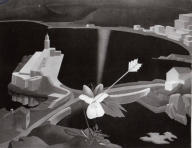



All texts copyright Richard Shillitoe
le phare
1939
Oil on panel.
27 x 35in. (63.5 x 88.9cm.)
Provenance
Sold by the Hamet Gallery, London, 1971.
Exhibited
London, Mayor Gallery, 1939, no. 1.
Northampton, Art Gallery, 1939.
London, Royal Academy of Arts, 1940, no. 1105.
AIA travelling exhibition, 1941, no. 8.
AIA travelling exhibition, 1942, no. 21.
Penzance, Newlyn Gallery, 1961, no. 9.
London, Hamet Gallery, 1971, no. 29, ill. b/w
One of the Méditerranée series.
The image brings to mind a passage in Goose of Hermogenes:
‘What does the pharos say, out there at the end of the jetty?’ I asked. ‘It flashes a message all
night through, long after every other lamp is out, but not a message of comfort. Keep away, it
says, I am alight, but so is the mountain! Keep away from these dangerous shores. And from
above the inland ranges, I shall be turned into blood, cries the moon; and the stars wide-eyed
with terror, sink back into their cavernous abyss.’ (p. 65)
The golden section has been incorporated into the composition in several ways. It determines the placement
of the landward side of the jetty and it marks the point at which the land meets the sea on the lower edge of
the painting. It also marks the point where the curve of the sea meets the spit of land on the right hand side.
The psychological focal point of the painting, where the arrow pierces the flower, has been determined by the
golden section.
No studies for Le Phare are known, but given that Rivières Tièdes (1939) depicts an actual church in Corsica,
one wonders whether, and to what extent, the setting for Le Phare is real.
The number of bays on the coast of the Greek mainland or Mediterranean islands that possess a settlement
and a lighthouse are legion, making identification difficult. If an auto-biographical element to the painting is
assumed, the strongest candidate must be Perachora, the archaeological site discovered by Humfry Payne in
1930 and excavated by him during the digging seasons of 1930-1933. It was a small fortified town in the
immediate neighbourhood of the lighthouse on Cape Hagios, across the gulf from ancient Corinth. The most
important building was the Heraeum, a temple dedicated to the goddess Hera. Colquhoun and Payne visited
there together in the summer of 1933, as Payne later reminisced: ‘As we went up the road from Kiato [near
Corinth] we had a marvellous view of the Perachora promontory, lying idly in a dazzling, calm sea, and I
thought of that day last July, when we were there, and of you bathing in the harbour…’.
Whatever its origins, this is an impersonal, dehumanised environment. Nature has been overcome but the
buildings that have conquered the landscape are largely inimical to life, being, with one exception, doorless
and windowless. The only remaining sign of life is the monstrous orchid, but it has been pierced to the heart,
forming an image of despair? Is this a township for the living or the dead?
The cartoon is known.


















